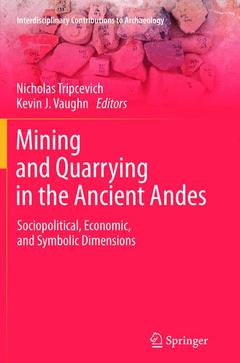Mining and Quarrying in the Ancient Andes, 2013 Sociopolitical, Economic, and Symbolic Dimensions Interdisciplinary Contributions to Archaeology Series
Langue : Anglais
Coordonnateurs : Tripcevich Nicholas, Vaughn Kevin J.

?Over the millennia, from stone tools among early foragers to clays to prized metals and mineral pigments used by later groups, mineral resources have had a pronounced role in the Andean world. Archaeologists have used a variety of analytical techniques on the materials that ancient peoples procured from the earth. What these materials all have in common is that they originated in a mine or quarry. Despite their importance, comparative analysis between these archaeological sites and features has been exceptionally rare, and even more so for the Andes. Mining and Quarrying in the Ancient Andes focuses on archaeological research at primary deposits of minerals extracted through mining or quarrying in the Andean region. While mining often begins with an economic need, it has important social, political, and ritual dimensions as well. The contributions in this volume place evidence of primary extraction activities within the larger cultural context in which they occurred. This important contribution to the interdisciplinary literature presents research and analysis on the mining and quarrying of various materials throughout the region and through time. Thus, rather than focusing on one material type or one specific site, Mining and Quarrying in the Ancient Andes incorporates a variety of all the aspects of mining, by focusing on the physical, social, and ritual aspects of procuring materials from the earth in the Andean past.
Chapter 1: Mining and Quarrying in the Andes: Economic, Political, and Symbolic Dimensions. .-PART I: STONEChapter 2: Quarrying and Production at the Quispisisa Obsidian Source.- Chapter 3: Variation in Inca Building Stone Quarry Operatoins in Ecuador and Peru.-Chapter 4: Building Taypikala: Changing Patterns of Stone Procurement and the Production of Twianaku Monumentality.-PART II: CLAYS AND MINERALS.-Chapter 5: Arcillas and Alfareros: Clay and Temper Mining Practices in the Lake Titicaca Basin.-Chapter 6: The Huarhua Rock Salt Mine: Possible Archaeological Implications of Modern Salt Extraction Practices.-Chapter 7: Hunter-Gatherer-Fisher Mining During the Archaic Period in Coastal Northern Chile.-Chapter 8: The Structure and Organization of Mining in Nasca from the Early Intermediate Period Through the Middle Horizon: Recent Evidence from Mina Primavera.- PART III: METALS.-Chapter 9: Amalgamation and Small-Scale Gold Mining in the Ancient Andes.-Chapter 10: Silver Mines of the Northern Lake Titicaca Basin, Peru.-Chapter 11: The Organization of Copper Mining During the Late Period in the Loa River, Northern Chile.-Chapter 12: Mining of Copper and Copper-Bearing Minerals in Ancient Peru: New Evidence from the Upper Ica Valley.-Chapter 13: Mining Archaeology in the Nasca and Palpa Region, South Coast of Peru.-PART IV: THE BROADER CONTEXT OF MINING AND QUARRYING IN THE ANDES.-Chapter 14: Written by Richard Burger.-Chapter 15: Written by: Izumi Shimada.
Dr. Nicholas Tripcevich is a member of the Archaeological Research Facility at the University of California, Berkeley. His research interests include Andean prehistory, social complexity, exchange theory, ethnoarchaeology, ancient mining, GIS, and lithic analysis. Dr. Kevin J. Vaughn is an Associate Professor in the department of Anthropology at Purdue University. His research interests include the emergence of social complexity, political economies of middle-range societies, craft production, ancient mining, village and household archaeology, the anthropology of pilgrimage, provenance analysis, archaeometry (INAA, LA-ICPMS, XRD, stable isotopes), ceramic analysis, Andean South America, Nasca.
Uses comparative analysis between major archaeological mining and quarrying sites throughout the Andes Places evidence of primary extraction activities within a larger cultural context Contains two synthesizing discussion chapters at the conclusion of the book Includes supplementary material: sn.pub/extras
Date de parution : 01-2015
Ouvrage de 354 p.
15.5x23.5 cm
Date de parution : 12-2012
Ouvrage de 354 p.
15.5x23.5 cm
Thème de Mining and Quarrying in the Ancient Andes :
© 2024 LAVOISIER S.A.S.
